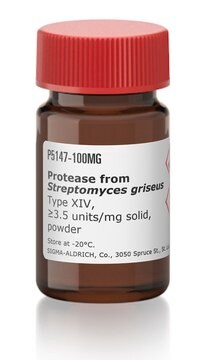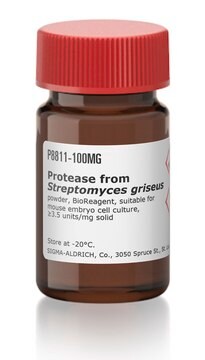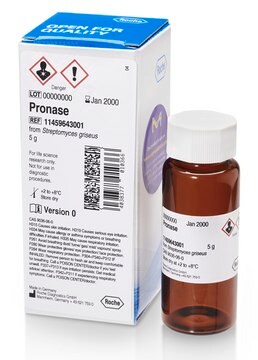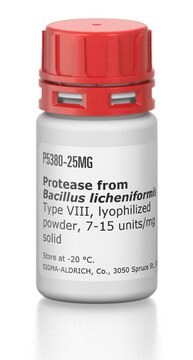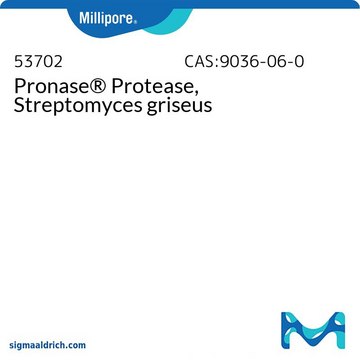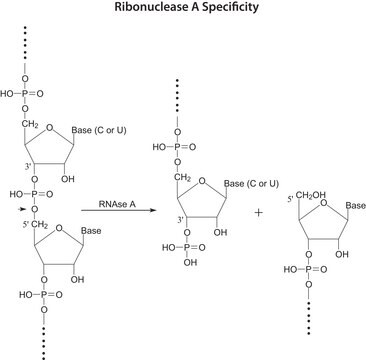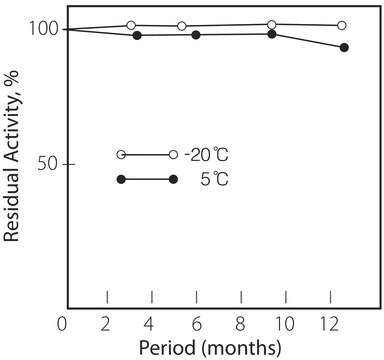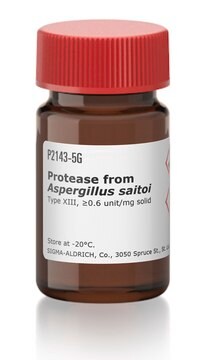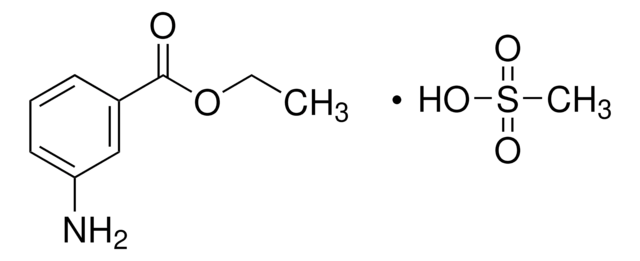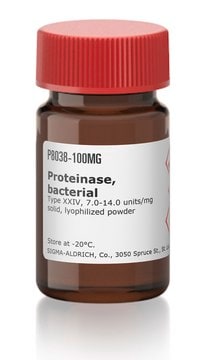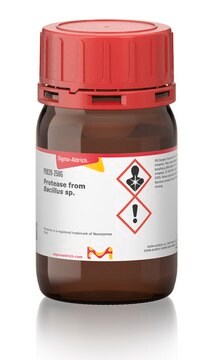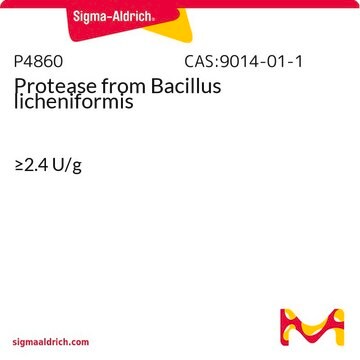추천 제품
일반 설명
A mixture of at least three proteolytic activities including an extracellular serine protease. In general, serine proteases display a wide range of substrate specificities, which are believed to be mediated by an active site composed of one Asp, one His, and a Ser residue in the molecule. This enzyme prefers to hydrolyze peptide bonds on the carboxyl side of glutamic or aspartic acid.
특이성
A mixture of at least three proteolytic activities including an extracellular serine protease. In general, serine proteases display a wide range of substrate specificities, which are believed to be mediated by an active site composed of one Asp, one His, and a Ser residue in the molecule. This enzyme prefers to hydrolyze peptide bonds on the carboxyl side of glutamic or aspartic acid.
애플리케이션
Protease is typically used in nucleic acid isolation procedures in incubations of 0.5-3.0 hours supplemented with 0.2% sodium dodecyl sulfate and 10 mM EDTA.
Suitable for:
- Nucleic acid isolation procedures in incubations
- Degrade protein during nucleic acid purification
- Proteolysis of insoluble protein
- Structural protein studies
This enzyme is more active at a higher pH range than the known alkaline protease, showing the proteolytic activity even in 0.2N NaOH solution. This enzyme is useful for proteolysis of insoluble protein and for structure investigation of protein.
물리적 특성
Completely inactivated by heating above 80 °C for 15-20 minutes.
단위 정의
One unit will hydrolyze casein to produce color equivalent to 1.0 μmole (181 μg) of tyrosine per min at pH 7.5 at 37 °C (color by Folin-Ciocalteu reagent).
제조 메모
Collected from culture broth of S. griseus.
분석 메모
The protease is incubated for 10 minutes at pH 7.5 at 37°C in a 6 ml reaction volume containing 0.54% casein and 0.041 M potassium phosphate buffer. The reaction is stopped by the addition of 5.0 ml of 0.11 M trichloroacetic acid.
기타 정보
This protease is completely inactivated by heating above 80°C for 15-20 minutes. This enzyme is more active at a higher pH range, showing the proteolytic activity even in 0.2N NaOH solution.
신호어
Danger
유해 및 위험 성명서
예방조치 성명서
Hazard Classifications
Eye Irrit. 2 - Resp. Sens. 1 - Skin Irrit. 2 - STOT SE 3
표적 기관
Respiratory system
Storage Class Code
11 - Combustible Solids
WGK
WGK 2
Flash Point (°F)
Not applicable
Flash Point (°C)
Not applicable
개인 보호 장비
Eyeshields, Gloves, type N95 (US)
이미 열람한 고객
D Y Yum et al.
Bioscience, biotechnology, and biochemistry, 58(3), 470-474 (1994-03-01)
SAP, an extracellular alkaline serine protease produced by Streptomyces sp. YSA-130, was purified to homogeneity by CM-Sephadex column chromatography and crystallization. The enzyme was a monomeric protein with a molecular weight of 19,000 as estimated by SDS-PAGE and gel filtration.
N Yoshida et al.
Journal of biochemistry, 104(3), 451-456 (1988-09-01)
A protease was purified 163-fold from Pronase, a commercial product from culture filtrate of Streptomyces griseus, by a series of column chromatographies on CM-Toyopearl (Fractogel), Sephadex G-50, hydroxyapatite, and Z-Gly-D-Phe-AH-Sepharose 4B using Boc-Ala-Ala-Pro-Glu-pNA as a substrate. The final preparation was
Hyun-Ju Cho et al.
Disease models & mechanisms, 12(5) (2019-05-03)
DYRK1A is a major causative gene in Down syndrome (DS). Reduced incidence of solid tumors such as neuroblastoma in DS patients and increased vascular anomalies in DS fetuses suggest a potential role of DYRK1A in angiogenic processes, but in vivo
P Bressollier et al.
Applied and environmental microbiology, 65(6), 2570-2576 (1999-05-29)
Streptomyces strain K1-02, which was identified as a strain of Streptomyces albidoflavus, secreted at least six extracellular proteases when it was cultured on feather meal-based medium. The major keratinolytic serine proteinase was purified to homogeneity by a two-step procedure. This
Aline C Habison et al.
PLoS pathogens, 13(9), e1006555-e1006555 (2017-09-15)
Many pathogens, including Kaposi's sarcoma herpesvirus (KSHV), lack tractable small animal models. KSHV persists as a multi-copy, nuclear episome in latently infected cells. KSHV latency-associated nuclear antigen (kLANA) binds viral terminal repeat (kTR) DNA to mediate episome persistence. Model pathogen
자사의 과학자팀은 생명 과학, 재료 과학, 화학 합성, 크로마토그래피, 분석 및 기타 많은 영역을 포함한 모든 과학 분야에 경험이 있습니다..
고객지원팀으로 연락바랍니다.